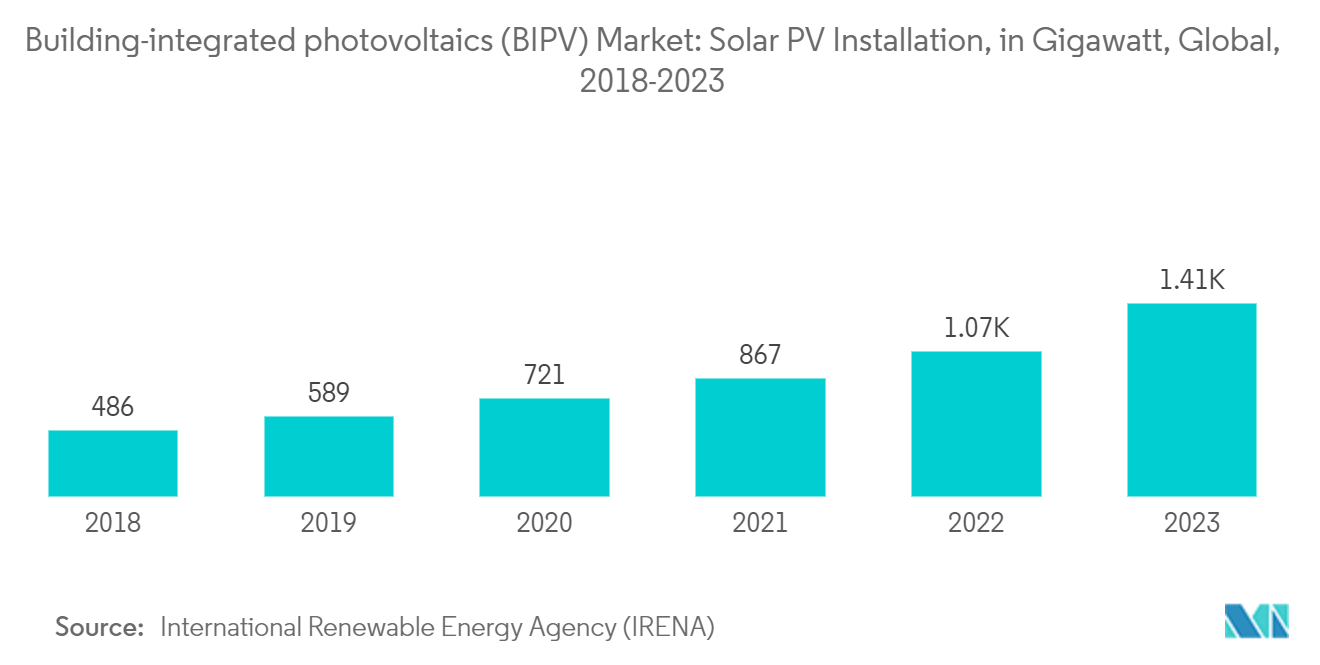Market Trends of Building Integrated Photovoltaic (BIPV) Industry
The Crystalline PV Segment is Expected to Dominate the Market
- Crystalline module is the dominant solar photovoltaic (PV) technology used in the building-integrated photovoltaics market. Conventional solar technology made using crystalline silicon accounts for over 80% of the solar market. Thus, as the most mature and widely used material for BIPVs, most of the solar panels utilized for facades, curtain walls, and roofs are made using crystalline silicon.
- Crystalline PV glass combines the benefits of traditional architectural glass with the ability to harness solar energy, making it a valuable component in the development of sustainable and energy-efficient buildings.
- This photovoltaic (PV) glass technology is ideal for buildings and facilities with favorable solar orientation aiming for optimal energy production. In addition to generating electricity, crystalline BIPV glass can contribute to the overall performance of a building. For instance, these glasses can provide shade, reduce cooling loads, and improve thermal comfort inside the building. Crystalline glass has a long lifespan, providing a reliable source of renewable energy for many years.
- In April 2024, India's Alpex Solar secured 7 acres of land from the Uttar Pradesh State Industrial Development Authority (UPSIDA) in Mathura, Uttar Pradesh. The plot will be used to set up a manufacturing facility for solar panels. The company manufactures PV modules using monocrystalline and polycrystalline cell technologies. Its product portfolio includes bifacial, mono-PERC, and half-cut solar PV modules.
- In April 2024, the US solar module maker First Solar inaugurated a new manufacturing facility in Tamil Nadu, India, with 3.3 GW of annual capacity. It is the country's first fully vertically integrated solar manufacturing facility, and it was built with an investment of USD 700 million. The company plans to manufacture solar PV modules, including crystalline solar PV modules.
- The increasing installation of solar PV modules worldwide is boosting the demand for BIPV systems. In 2023, the total solar PV installed capacity was around 1412 GW, which increased from 1066 GW in 2022.
- Several companies offer a variety of crystalline solar PV modules based on requirements. For instance, Invitaic, a company with expertise in BIPVs, offers a diverse product range for BIPVs that includes ultra-black solar panels, transparent solar panels, and polychrome solar panels, all designed with the latest Topcon technology.
- Such developments are expected to have an overwhelming effect on the development of the building-integrated photovoltaics market.

Asia-Pacific is Expected to Dominate the Market
- Asia-Pacific has successfully implemented solar PV technologies in many industries in the most cost-effective way. The technology in the region has reached the maturity stage and has witnessed continuously plummeting prices.
- Countries like China, India, Japan, and ASEAN have proved themselves in solar power generation with new innovative technologies for BIPVs, rooftops, and many other applications. China's production scale for each technology in the PV industry accounts for more than 50% of the world. The country is expected to remain at the top in the future.
- BIPVs play a significant role in advancing sustainability in the construction industry by generating clean energy, reducing carbon emissions, and promoting energy efficiency. PV-integrated buildings are poised to gain significant advantages as green building certifications gain traction, establishing themselves as icons of sustainable development and generating a more eco-friendly future.
- In February 2024, Jindal Steel & Power Ltd (JSPL) announced the commissioning of a building-integrated rooftop solar project with an installed capacity of 3.25 MWp and an area of 2,00,000 sq. ft.
- Similarly, in October 2023, SP Group (SP) announced the successful completion and subsequent grid integration of its building-integrated photovoltaic (BIPV) project in Guangdong, China. A four-megawatt-peak (MWp) BIPV project will be installed at Guangdong Lingxiao's new manufacturing facility in Yangchun City. Based on a surplus-to-grid model, the BIPV project is expected to generate 110 million kilowatt hours of clean energy over the next 25 years, or 4.36 million kilowatt hours per year.
- In May 2023, ClearVue Technologies Limited, an Australian smart building materials company, announced the official release of its improved product design for integrating solar vision glass into glazing units or IGUs. The company also released its new integrated solar façade solutions.
- Owing to such developments, Asia-Pacific is expected to dominate the market in the coming years.


